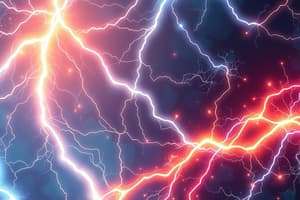Podcast
Questions and Answers
Which particles make up an atom?
Which particles make up an atom?
- Protons
- Neutrons
- Electrons
- All of the above (correct)
What happens to the charge of an object when electrons are added?
What happens to the charge of an object when electrons are added?
- The charge becomes neutral
- The object becomes positively charged
- The object becomes negatively charged (correct)
- The charge remains the same
What happens to the charge of an object when electrons are removed?
What happens to the charge of an object when electrons are removed?
- The charge becomes neutral
- The charge remains the same
- The object becomes negatively charged
- The object becomes positively charged (correct)
What happens when two objects with the same charge come into contact?
What happens when two objects with the same charge come into contact?
What happens when two objects with different charges come into contact?
What happens when two objects with different charges come into contact?
Which subatomic particle can move from one object to another?
Which subatomic particle can move from one object to another?
Which one of the following is true about the charge of an object when electrons are added?
Which one of the following is true about the charge of an object when electrons are added?
What happens to the charge of an object when electrons are removed?
What happens to the charge of an object when electrons are removed?
What happens when two objects with the same charge come into contact?
What happens when two objects with the same charge come into contact?
What is friction?
What is friction?
Flashcards are hidden until you start studying
Study Notes
Composition of an Atom
- Atoms consist of three primary subatomic particles: protons, neutrons, and electrons.
- Protons carry a positive charge, neutrons are neutral, and electrons have a negative charge.
Charge Changes with Electron Manipulation
- Adding electrons to an object increases its negative charge.
- Removing electrons from an object decreases its negative charge, potentially leading to a positive overall charge.
Interactions Between Charged Objects
- When two objects with the same charge come into contact, they repel each other.
- When two objects with different charges make contact, they attract each other, potentially leading to charge transfer.
Movement of Subatomic Particles
- Electrons are the only subatomic particles that can move freely from one object to another.
Understanding Friction
- Friction is a force that opposes the relative motion of solid surfaces, fluids, or material elements sliding against each other.
- It can cause charge buildup when electrons are transferred between two surfaces during contact.
Studying That Suits You
Use AI to generate personalized quizzes and flashcards to suit your learning preferences.




